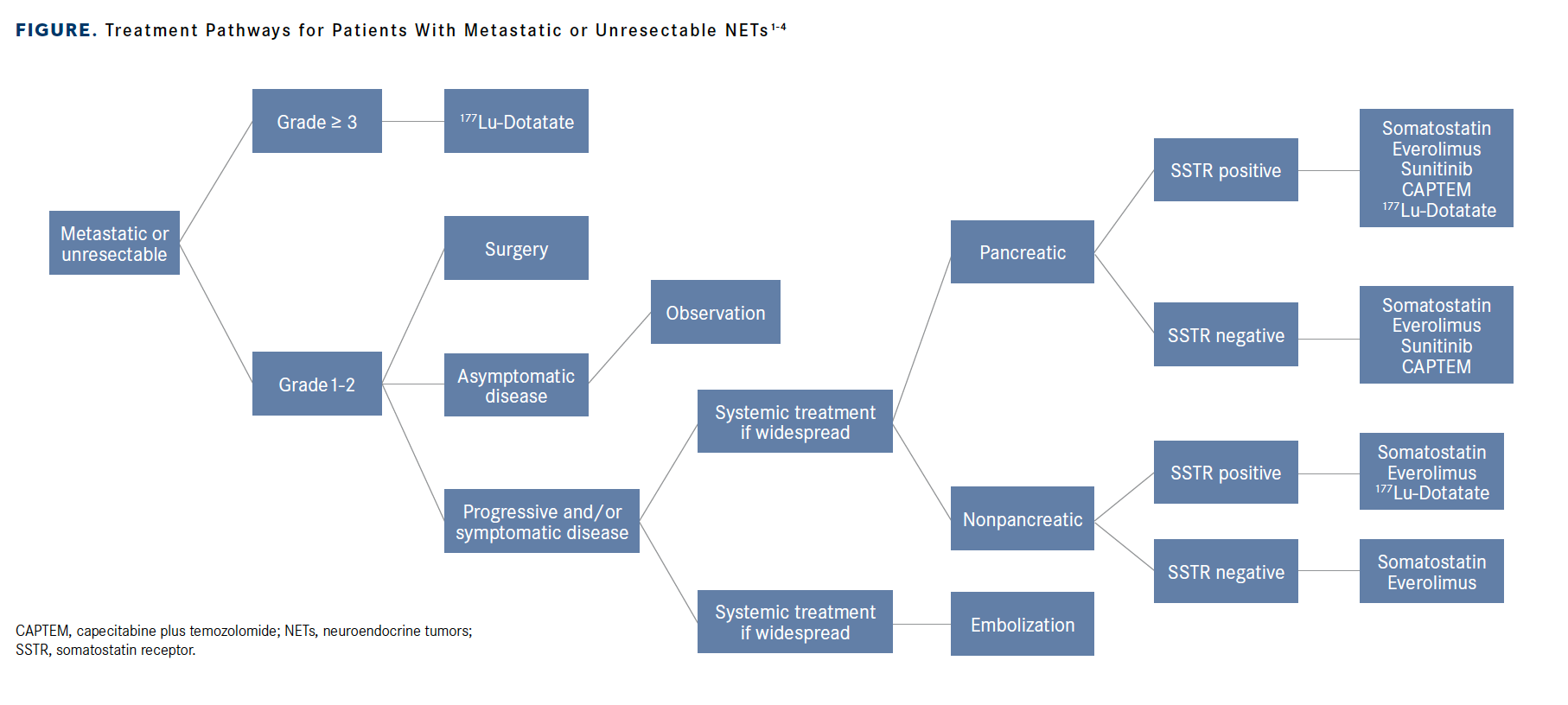Publication
Article
Oncology Live®
Unmasking NETs Requires a Multifaceted Approach to Care
Author(s):
Eric Liu, MD, FACS, reviews treatment options, pitfalls of diagnoses, and the importance of involving specialists and advocates early in neuroendocrine tumors.

Complex in their development, diagnosis, and treatment, neuroendocrine tumors (NETs) present a challenge to clinicians who may only see a few cases during their career. NETs are slow growing with a symptom burden that may be attributable to other disease states. Delayed diagnoses result in patients presenting with late-stage disease.
“NETs are what I call an unusual disease,” Eric Liu, MD, FACS, said in an interview with OncologyLive®. “NETs used to be considered quite rare [and] it’s one of those diseases where we do not receive that much education on it in medical school or in our training process. So, it’s kind of an unusual, unknown disease, but it affects a lot of [individuals].” Liu is surgical director of the Neuroendocrine Institute at Rocky Mountain Cancer Centers in Denver, Colorado.
As a community oncologist with a specialty in NETs, Liu highlighted the most important aspect of the disease: awareness. “The neuroendocrine system is [one] that no one ever talks about. We talk about the respiratory tract and the digestive tract and the central nervous system and even the endocrine system. But the neuroendocrine system is more like what we call the diffuse endocrine system that controls a lot of things in the background. There are tiny little cells scattered all throughout the body—in the lungs, through the digestive tract— called neuroendocrine cells, and they can turn into cancers,” he said.
In a discussion of the disease state, Liu reviewed treatment options chronic [disease]; some of my colleagues call it “cancer in slow motion.” (Figure1-4), pitfalls of diagnoses, and the importance of involving specialists and advocates early. “NETs are a disease for which, luckily, we have many clinicians who are experts in and really specialize in them,” he said. “Unfortunately, it is not a well-known disease that [all practitioners] can take care of. I always encourage [colleagues], if they see this unusual diagnosis, to seek expert opinions.”
Figure. Treatment Pathways for Patients With Metastatic or Unresectable NETs1-4

Please discuss the diagnostic approach for these tumors. What are the common traits that patients present with in the clinic?
The diagnosis of neuroendocrine cancer is very complicated, and the reason is because the symptoms can be extremely mild. Neuroendocrine cancers tend to be more of a chronic [disease]; some of my colleagues call it “cancer in slow motion.”
Because it can linger for a long time, the diagnosis can be tough to make [and] in lots of cases [individuals] have mild symptoms [including] abdominal pain, a little flushing here and there, maybe some diarrhea, and [they] come and go in some cases. For example, a patient will present with abdominal pain in the emergency department and an x-ray will look normal, and [a clinician] won’t see [any sign of NETs]. This pain will come again [and] eventually, the patient may get a CT scan, and [receive a] diagnosis of NETs. [Other times], there are no symptoms at all, and the patient can present all out of the blue with sudden abdominal pain or NETs can even be found incidentally on a CT scan for another reason, or possibly even [during] an endoscopy or a colonoscopy.
It is a tough diagnosis to make. [Let’s take an example of] a 50-year-old woman who presents with flushing, a very common symptom for NETs. If that is the situation, a gynecologist may present a diagnosis of menopause. [What if a] patient has persistent diarrhea? A gastroenterologist may prescribe a colonoscopy and results may not show anything but the symptom persists. The gastroenterologist may give a diagnosis of irritable bowel syndrome. You can see how these mild symptoms can very easily be misinterpreted, and the diagnosis of NETs is not made for a long time.
Unfortunately, the treatments for irritable bowel syndrome and menopause do not treat cancer and so as the symptoms persist, the disease persists. Thankfully, it’s a slow growing disease in general and individuals can live with it for a long time. It is a very challenging diagnostic dilemma. But once the diagnosis is made, thankfully there is a lot we can do to help patients.
Luckily, we do have good diagnostic techniques to [confirm NETs]. The easiest one is a CT scan, [which is] quick, standard, lots of [individuals] can get it, it’s not very expensive, and it provides a survey of the lungs, stomach, and pelvis. That is frequently how we make the diagnosis of NETs by seeing a mass either in the intestines, the pancreas, or the liver.
We also have different blood tests as well; however, they are not quite as good. Unfortunately, [because] NETs are slow growing, and individuals can have them for many years without any symptoms, [they] frequently [are] diagnosed very late, usually stage IV. Stage III [disease] tends to include spread to the local lymph nodes, but stage IV is when it spreads far, for example to the liver, bones, or lungs.
NETs typically start in the lungs, pancreas, or small intestine, which are the 3 most common points of origin [and] even though it has a reputation for being a very slow disease, it is aggressive in the way that it spreads. Neuroendocrine disease is not benign; it is a highly metastatic disease that can be life threatening.
How do you decide whether to pursue looking for NETs?
We must consider comorbidities and age [at the time of diagnosis], which is usually 60 years, but can be seen in a patient who is age 40 or 50 years. Treatments can be quite varied and include medicines, surgery, special kinds of radiation, and different kinds of therapies for the liver…. [We must] take into consideration the overall general health of the patient.
For example, if the patient has many comorbidities, such as diabetes, or a history of stroke, and they are elderly and very frail, maybe the treatment for the neuroendocrine disease needs to take a back seat to something else, because if a patient is going to die, for example due to a stroke or a heart attack, NETs may not be the most life-threatening aspect of their health. But if a patient is quite healthy, they don’t smoke, and are doing well, my goal is always to keep the patient healthy. And our goal, as it should be for everything, is to heal the patient so that they can live a high quality of life. If I can help improve quality of life, that’s always my No. 1 priority.
What are the typical treatments that you are looking to initiate once a patient has received a diagnosis of NETs?
Despite neuroendocrine [disease] being a relatively unusual and rare, we have many different types of therapies. And the reason that I encourage patients to see specialists is because choosing the tools in the toolbox can be very challenging. We need to decide what is best for the patient and one tool clinicians forget is surveillance. Then we have other types of medicines, because neuroendocrine [cancer] is a hormonal disease, and one of the unusual things is that NETs may affect blood sugar [and] they may cause pain. And so, getting those hormones under control is very important.
But there’s no question that up front one of the most powerful therapies that we have for neuroendocrine disease is surgery. If we can remove a lot of the bulk of the tumor, we can remove a fair amount of the hormone burden, which is not usually the case for other cancers.
However, a lot of the times the disease goes to the liver, and we can use embolization. Additionally, one of the most exciting therapies we have is called PRRT, or peptide receptor radionuclide therapy, which combines hormonal therapy with radiation that goes straight to the tumor and the radiation treatment [is delivered] from the inside out. It’s very effective in helping to control the disease. It is not a cure, but it can help patients with symptoms and can help slow down the growth of their tumors.
Are there any other unmet messages you would like to convey to the community oncologist regarding NETs?
I always say, have a buddy. Have a friend who specializes in neuroendocrine disease who you can talk to. I should stress that I am community physician, so I understand what it is to be out there working with patients in their community. I’ve seen 2000 cases of NETs and I’ve learned how vastly complicated the disease really is. What I always tell clinicians is, don’t be shy, order all the tests, gather all the information up front so you can have all the correct data and can make the best decision.
One of the problems I see frequently as a specialist who receives referrals is that sometimes the patient did not have a complete workup. [In some cases] the clinicians jumped to [one type of] surgery, when in fact maybe you could have done a little better surgery if you had more information. Or in other cases, the wrong therapy was administered because the pathology was misinterpreted. There are lots of different ways that the devil is in the details.
I always encourage my colleagues across the United States [to see this as] a team effort. I am happy that the patient always has their [primary oncologist] at home because they get their treatments, shots, and their scans [locally] and they don’t have to fly to Denver, Colorado to see me every single month; that would be ridiculous. If we can work together, and I can share some of my experience with you, we can come up with the best plan for the patient. That is always the best that we can do.
I don’t know everything about brain cancer, bone cancer, or bladder cancer but I know a lot about neuroendocrine cancer. And so, I am happy to rely on my colleagues who really specialize in those other things.
There is one other thing I do want to share, neuroendocrine disease really isn’t that rare, and there is a lot we can do to help patients. Unfortunately, the information is not readily and easily available, which means that individuals need to advocate for themselves—either the patient needs to advocate, or the physician needs to advocate—get the right tests, seek second opinions, don’t worry about having to travel because you might have to do that.
Luckily, if anything has come from the COVID-19 pandemic, it is that we do a lot more telemedicine now. Reach out and see [whether] some of the experts in the United States would be willing to see you through telemedicine and review your case. A lot of the time, a physician at home can conduct the physical exam and with the advanced scans that we have, I can see right into their bodies. So, most of the time, they just need me to think about the case.
Think about getting a second opinion, think about working with a specialist, make sure you get a comfortable team around you. If they say something is impossible, that might not always be true.

References
- Zhang JY, Kunz PL. Making sense of a complex disease: a practical approach to managing neuroendocrine tumors. JCO Oncol Pract. 2022;18(4):258-264. doi:10.1200/OP.21.00240
- Lutathera. Prescribing information. Advanced Accelerator Applications USA, Inc; 2020. Accessed April 20, 2022. bit.ly/3EyZxOn
- Afinitor. Prescribing information. Novartis; 2022. Accessed April 20, 2022. bit.ly/3K1NBpd
- Sutent. Prescribing information. Pfizer; 2021. Accessed April 20, 2022. bit.ly/3xP9wgO










